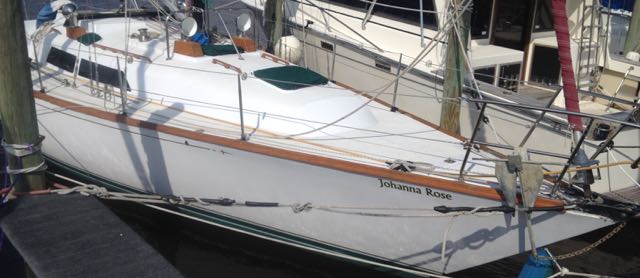The Old Plywood Doors
The Landfall 38 comes from the factory with 3 interior doors. One for the v-berth cabin, a second for the head, and another separating the aft cabin from the main saloon. Some Landfalls are outfitted with rather nice teak faced doors whereas others came with a cheap wood-patterned formica laminate. The ones which came with Johanna Rose was the later. In both cases, the doors are constructed from marine plywood with a small cutout section for teak louvers. The photo to the right shows a laminated door for the head compartment. It looks much better in the photo than in reality.
When I first purchased Johanna Rose, the original doors were in ruff shape and were not even installed. At the time, I looked into purchasing new teak panel doors. I found a place in the Tampa Bay area which fabricates custom teak woodwork. The price for two new teak panel doors, compared to prices I found at other companies, was somewhat reasonable at $1,630 delivered. But the reality was that I had a lot of other items to get and more important projects to work on, so I made due with the doors I had.
 |
| Attempt to refinish a laminated door |
Laminate Removal and Attempted Refinish
Due to aging, the glue for the laminate of v-berth door was severely separating and started to flap open on the bottom. Looking closely behind the laminate, revealed what looked like nice teak facing on the marine plywood below. I removed both laminate faces and then tried to remove the old glue with chemicals, heat and a scraper, and finally some sanding. The clean up did not work well, and It looked like I might have been a bit aggressive and sanded through the teak facing. I tried to match the underlying wood faces with the outer layer by using lighter and darker stains, and as seen on the photo to the left, was not that successful. In reality though, the refinished door looked better than the cheap looking formica laminated door.
Teak deal on Ebay

While searching for some teak on Ebay I came across a listing for several new marine teak doors. The listing stated they were originally made for a yacht interior. The dimensions were a about an inch wider than needed which was fine as I wanted to trim the doors and add rounded top corners.
I purchased one door, and when it arrived, I ordered two more doors. The price $125 each and under $50 for shipping all three.
Installing New Teak Door
I'm the kind of guy that never throws away anything which may be useful down the line. And while I removed the old laminate from the v-berth door, I keep it. It turned out to be a useful pattern for marking the a new door for trimming. The sides of the door were trimmed on a table saw by removing 5/16" on each side. A jigsaw was used to trim the rounded top corners, and an orbital sander was used to smooth the edges. I reused the original door hardware save for the hinges which were replaced with a 48" long stainless-steel piano hinge purchased from Home Depot online. The photo below shown the new doors for the v-berth and the head. The first one on the left shows the new unfinished v-berth door installed whereas to its right is a photo of the door after two coats of Helmsman Spar Urethane. The bottom row shows photos of the new door to the head. In addition to
trimming the door width and rounding the top courners, a strip of teak was added to the bottom to increase the door height.
 |
| The new door to the v-berth shown unfinished. | |
|
 |
| The new door to the v-berth shown finished. |
|
|
 |
| The new door to the head shown finished |
 |
The new door to the head. In addition to
trimming the door width, a strip of teak was
added to the bottom to increase the door height. |
 |
Installation of the new aft teak door. The
doorway joining the aft cabin to the main saloon
required fabricating all new teak molding and
header board. This photo shows the dry fit before
final installation, hardware mounting, and finish. |

































